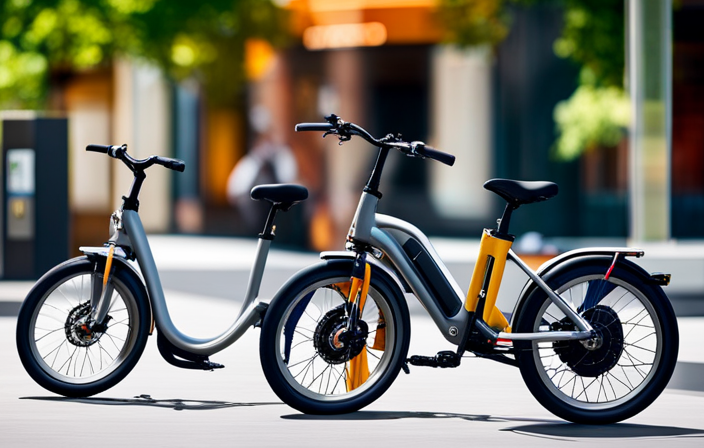Locking up an electric bike is no small feat. With the rising popularity of these high-tech two-wheelers, thieves are constantly on the prowl. But fear not, for I have the ultimate guide to keep your electric bike safe and secure.
From assessing security risks in your area to using a combination of high-quality locks, I’ll walk you through the steps to ensure your prized possession stays exactly where you left it.
So, let’s dive in and learn how to fortify your electric bike against the hands of would-be thieves.
Key Takeaways
- Evaluate local crime rates and research recent incidents and patterns to determine the level of risk in your vicinity.
- Consider different types of bike locks available, such as U-locks, chain locks, and cable locks, and use a combination of locks for added security.
- Assess the quality and reliability of bike locks, using sturdy locks made of hardened steel and passing the lock through both the frame and wheels to prevent thieves from removing parts without damage.
- Secure your bike to a fixed object, such as bike racks, lampposts, or railings, in well-lit and visible areas to decrease the chances of theft.
Assess the Security Risks in Your Area
Before you lock up your electric bike, it’s crucial to assess the security risks in your area. Start by assessing local crime rates to understand the likelihood of bike theft in your vicinity. Look into recent incidents and determine if there is a pattern or if thefts are sporadic.
Additionally, evaluate bike theft prevention measures that are currently in place. Are there any bike racks or secure parking facilities available? Are there surveillance cameras or security guards in the area? This information will help you gauge the level of risk and determine the necessary precautions to take.
Once you have assessed the security risks, you can move on to choosing a high-quality locking system that will provide the best protection for your electric bike.
Choose a High-Quality Locking System
To ensure maximum security for your e-bike, opt for a top-notch locking system that’ll keep your two-wheeler safe and sound. When assessing bike locks, it’s crucial to consider the different types available in the market.
U-locks, also known as D-locks, provide excellent security due to their hardened steel construction. They are resistant to cutting and leverage attacks, making them a reliable choice.
Chain locks are another option that offers flexibility and durability. Look for chain locks with thick, tough links and a sturdy padlock.
Cable locks, while lightweight and easy to carry, are not as secure as U-locks or chain locks. It’s important to choose a cable lock with a thick, braided steel cable for enhanced protection.
To further enhance security, consider using a combination of locks, such as pairing a U-lock with a chain lock or cable lock. This multi-layered approach will deter potential thieves and provide added peace of mind.
Transitioning into the next section, let’s explore the importance of using a combination of locks to maximize security.
Use a Combination of Locks
For ultimate protection, don’t forget to mix and match your chosen locks, ensuring a layered defense against potential thieves. Assessing vulnerabilities is crucial when deciding how many locks to use. By using multiple locks, you significantly decrease the chances of your electric bike being stolen. To help you understand the importance of this strategy, let’s look at a table that showcases the advantages of using a combination of locks.
| Lock Type | Advantages |
|---|---|
| U-Lock | Provides excellent resistance to cutting tools |
| Cable Lock | Offers flexibility for securing different parts of the bike |
| Folding Lock | Compact and easy to carry, yet still offers strong protection |
By utilizing a combination of locks, you address various weaknesses that each lock may have individually. This makes it harder for thieves to bypass your bike’s security measures. Now, let’s move on to the next step: locking the frame and wheels securely.
Lock the Frame and Wheels
Now, let’s delve into securing both the frame and wheels of your ride.
When it comes to locking the frame and wheels of your electric bike, it is essential to assess the quality and reliability of your bike locks. Look for sturdy locks made of hardened steel that are resistant to cutting and picking.
It is also crucial to find secure parking spaces that are well-lit and have surveillance cameras. When locking your bike, make sure to pass the lock through the frame and wheels, ensuring that both are secured. This will make it difficult for thieves to remove any part of your bike without damaging it.
By taking these proactive measures, you can significantly decrease the chances of theft.
Now, let’s move on to the next section and learn how to secure your bike to a fixed object.
Secure Your Bike to a Fixed Object
When it’s time to secure your ride, fasten your bike to a solid object for added protection. Assess the locking system of your electric bike to ensure it can effectively deter thieves. Look for a sturdy fixed object that is immovable, such as a bike rack, lamppost, or railing. Avoid trees or flimsy structures that can be easily cut or broken. To help you choose the right fixed object, consider the following table:
| Fixed Object | Pros | Cons |
|---|---|---|
| Bike Rack | Secure and visible | Limited availability |
| Lamppost | Strong and stable | Not always present |
| Railing | Convenient location | Potential for damage |
Remember, the key is to select a fixed object that is both secure and easily visible. By following this step, you can significantly reduce the risk of theft. Park in well-lit and visible areas to further enhance the security of your electric bike.
Park in Well-Lit and Visible Areas
When it comes to securing your electric bike, one important aspect to consider is where you park it. By choosing well-lit and visible areas, you increase the chances of deterring potential thieves. Brightly lit areas provide a sense of security and make it more difficult for thieves to go unnoticed.
Additionally, parking your electric bike in a visible location allows passersby to keep an eye on it, adding an extra layer of protection. It is also recommended to choose areas with bike storage options, such as designated racks or lockers, as these provide a more secure place to leave your bike.
By following these guidelines, you can significantly reduce the risk of theft and ensure the safety of your electric bike.
Now, let’s move on to the next section about registering your electric bike.
Register Your Electric Bike
To ensure the utmost protection for your valuable ride, it’s essential that you take the step of officially registering your trusty two-wheeler.
Registering your electric bike not only complies with legal requirements, but it also offers several benefits in terms of electric bike maintenance. By registering your electric bike, you create a record that can be helpful in case of theft or damage. It provides proof of ownership and makes it easier to recover your bike if it is stolen.
Additionally, registering your electric bike may also qualify you for certain insurance benefits or discounts. So, don’t delay! Take the proactive step of registering your electric bike today to safeguard your investment and enjoy the peace of mind that comes with it.
Once your registration is complete, let’s move on to the next section about removing valuables and accessories, ensuring comprehensive protection.
Remove Valuables and Accessories
Make sure you take off any valuable items and accessories from your e-bike to prevent loss or damage. Assessing vulnerability is crucial in determining which accessories should be removed. Here are four items that should be secured separately when locking up your electric bike:
-
Remove the battery pack: This is one of the most valuable components of your e-bike and can easily be stolen if left attached.
-
Detach the display panel: The display panel provides information about your ride and can be tempting for thieves. Keep it safe by taking it with you.
-
Secure your saddle and seat post: Saddles are often targeted by thieves, so consider using a quick-release mechanism for easy removal or use a lock specifically designed for securing your saddle.
-
Take off any external accessories: Lights, panniers, or phone holders can be easily removed and should be stored separately to avoid theft or damage.
By securing these items separately, you decrease the risk of losing valuable accessories.
To further protect your electric bike, let’s move on to the next section about using a GPS tracking device.
Use a GPS Tracking Device
After removing valuables and accessories from your electric bike, it’s important to take additional measures to ensure its security.
One highly effective method is to use a GPS tracking device. These devices offer numerous advantages in tracking and recovering stolen bikes.
By installing a GPS tracker, you can monitor the whereabouts of your bike in real-time and receive instant notifications if it’s moved without your knowledge. This allows you to take immediate action, contacting authorities and providing them with accurate location data.
Additionally, GPS trackers can help deter potential thieves, as the knowledge that a bike is being tracked may discourage them from attempting theft in the first place.
While GPS tracking is an excellent option, it’s also worth considering alternative locking methods. These can provide an extra layer of protection, complementing the tracking device.
However, even with these precautions, it’s essential to consider insurance coverage for your electric bike.
Consider Insurance Coverage
Having insurance coverage for my e-bike is a prudent decision that provides peace of mind and financial protection in case of theft or damage. When considering insurance coverage, it’s important to find the right insurance provider that offers comprehensive coverage specifically tailored for electric bikes. This ensures that I am adequately protected and can easily make a claim if needed.
I also need to consider deductibles, which are the amount I would have to pay out of pocket before the insurance coverage kicks in. It’s essential to choose a deductible that I can comfortably afford.
In terms of emotion, knowing that my e-bike is insured gives me a sense of security and confidence when riding. Insurance coverage allows me to enjoy the benefits of my electric bike without worrying about potential risks.
Moving forward, it’s important to be mindful of public transportation options to further enhance the security of my e-bike.
Be Mindful of Public Transportation
Now that we have considered insurance coverage for our electric bike, let’s move on to the next step: being mindful of public transportation. As an eco-conscious individual, I am always looking for ways to reduce my carbon footprint and contribute to a cleaner environment. One great way to do this is by incorporating mindful commuting into my daily routine. By utilizing public transportation systems such as buses or trains, I can significantly reduce the number of cars on the road and decrease air pollution. Additionally, public transportation often provides designated spaces for bikes, making it a convenient option for electric bike owners. To further illustrate this, please refer to the table below:
| Pros of Mindful Commuting | Cons of Mindful Commuting |
|---|---|
| Reduces carbon footprint | May require more time |
| Saves money on fuel | Limited schedule options |
| Less stressful | Potential for overcrowding |
By being mindful of public transportation, we can contribute to a greener future while also ensuring the safety of our electric bike. Now, let’s move on to the next section about taking advantage of secure bike parking facilities.
Take Advantage of Secure Bike Parking Facilities
Utilizing secure bike parking facilities ensures peace of mind as you entrust your eco-friendly ride to a protected space. When it comes to electric bikes, which are often more expensive than traditional bicycles, it is crucial to take advantage of these facilities to prevent theft and damage.
Here are three reasons why secure bike parking facilities are worth considering:
-
Convenience: Many secure bike parking facilities are strategically located near popular destinations and public transportation hubs, making it easier for you to access your bike when needed.
-
Added Security: These facilities often provide additional security measures such as surveillance cameras, access control systems, and bike lockers to safeguard your electric bike from theft.
-
Compatibility with Bike Sharing Programs: Some secure bike parking facilities are designed specifically for bike sharing programs, allowing you to safely park your electric bike when you’re not using it.
By exploring alternative parking options, you can ensure the safety of your electric bike while contributing to a sustainable transportation solution.
Educate yourself on local bike theft laws to further protect your valuable investment.
Educate Yourself on Local Bike Theft Laws
Make sure you’re in the know about the bike theft laws in your area to protect your two-wheeled investment and keep your eco-friendly ride safe. Understanding the legal consequences and penalties for bike theft can help you take proactive steps to deter potential thieves.
In many jurisdictions, bike theft is considered a serious offense, with offenders facing fines, probation, and even jail time. Additionally, knowing how enforcement and police cooperation work can greatly increase the chances of recovering your stolen bike. Some cities have dedicated bike theft units within their police departments, and they actively collaborate with the community to prevent and solve bike theft cases.
By educating yourself on these laws and working with law enforcement, you can contribute to a safer biking community. Transitioning into the next section, consider joining a community watch program to further enhance bike theft prevention efforts.
Join a Community Watch Program
Consider becoming a member of a community watch program to actively participate in the prevention of bike theft and ensure the safety of your beloved two-wheeler. By engaging with your community and taking a proactive stance on neighborhood safety, you can make a significant impact in deterring potential thieves.
Here are four reasons why joining a community watch program is beneficial:
-
Increased visibility: By regularly patrolling the neighborhood, community watch members create a strong presence that helps deter criminals.
-
Quick response: With a community watch program in place, there is a faster and more coordinated response to suspicious activity, increasing the chances of catching thieves in the act.
-
Sharing information: By sharing information within the community, you can stay informed about recent bike theft incidents and take necessary precautions.
-
Education and training: Community watch programs often provide training sessions on crime prevention, allowing you to gain valuable knowledge and skills.
By actively participating in a community watch program, you can contribute to a safer neighborhood for all, reducing the risk of bike theft and ensuring the security of your electric bike. Stay vigilant and report any suspicious activity to further enhance the effectiveness of these initiatives.
Stay Vigilant and Report Suspicious Activity
As a member of a Community Watch Program, I understand the importance of staying vigilant and reporting suspicious activity.
By keeping watchful eyes on our surroundings, we can actively contribute to crime prevention and ensure neighborhood safety.
One of the key aspects of community involvement is to stay alert and report any incidents that seem out of the ordinary. This not only helps in creating public awareness but also strengthens the reporting system.
Being proactive in taking measures to maintain the security of our electric bikes is crucial. By actively participating in the reporting process and staying aware of suspicious behavior, we can collectively work towards a safer environment.
Let’s remember that our watchful eyes and timely reporting can make a significant difference in deterring potential thefts and ensuring the overall security of our community.
Frequently Asked Questions
What type of lock is the most secure for an electric bike?
The most secure bike lock for an electric bike is a reinforced, military-grade titanium lock designed to withstand the strength of a thousand Hulk smashes. It ensures maximum protection and prevents any chance of electric bike theft.
Can I use a regular bike lock to secure my electric bike?
No, it is not recommended to use a regular bike lock to secure an electric bike. Specialized electric bike locks offer added security features such as higher strength, anti-theft mechanisms, and compatibility with the bike’s unique design.
Are there any specific precautions I should take if I live in a high-risk area for bike theft?
Living in a high-risk area for bike theft requires extra precautions. Best practices for securing an electric bike include using a sturdy U-lock, securing both the frame and wheels, and parking in well-lit areas with high foot traffic.
Should I remove the battery from my electric bike when locking it up?
I should remove the battery from my electric bike when locking it up to prevent theft. This will make the bike less attractive to thieves and protect the valuable battery from being stolen.
Are there any additional steps I can take to increase the security of my electric bike?
To enhance the safety of my electric bike, I can implement additional security measures such as using a sturdy lock, opting for a GPS tracker, and employing best practices like parking in well-lit areas.
Conclusion
In conclusion, securing your electric bike requires a proactive and detail-oriented approach. By assessing the security risks in your area and using a high-quality locking system, you can significantly reduce the chances of theft. Remember to lock both the frame and wheels and secure your bike to a fixed object.
Interesting statistic: Did you know that in the United States, approximately 1.5 million bicycles are stolen each year?
Stay vigilant, educate yourself on local bike theft laws, and take advantage of secure bike parking facilities to protect your valuable investment.















